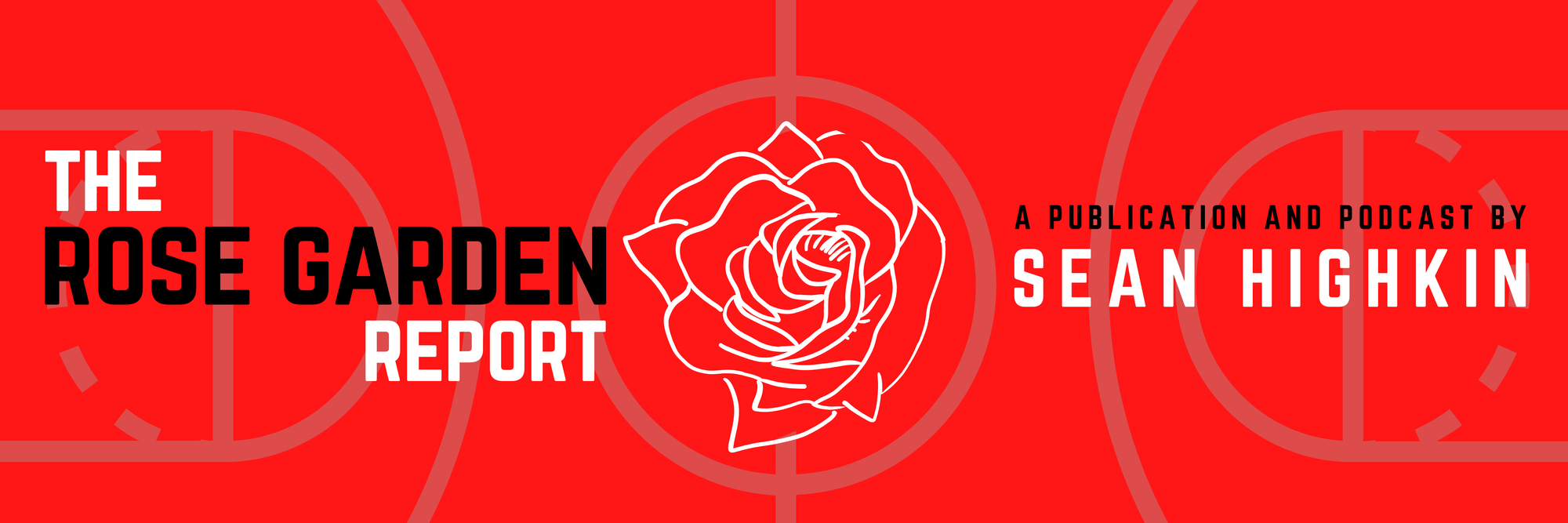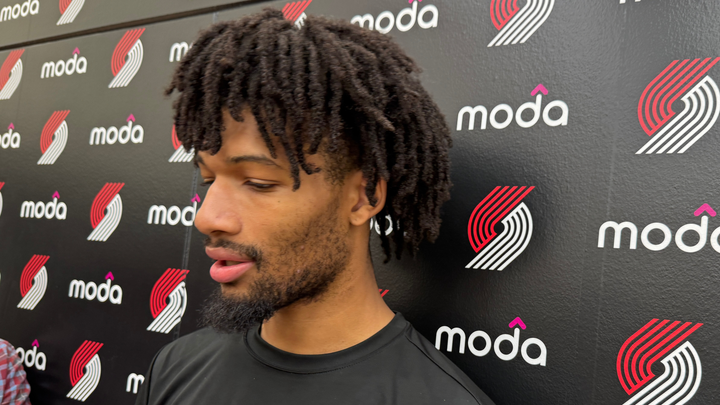Joe Cronin's Summer of Hard Choices
The Trail Blazers didn't get an extended look at their young core due to injuries. They have to make some decisions anyway.

📍 TUALATIN, Ore. — The surest sign that Joe Cronin is growing into the big job is that he’s learned not to say anything.
If you’re looking through the Trail Blazers’ general manager’s Monday end-of-season media availability for clues about what might happen this offseason—where he’s leaning in the draft, which veterans are on the trade block, how many games he wants to win next season—you’re not going to find much. The only news Cronin made was confirming that Chauncey Billups, as expected, would be back as head coach next season.
Monday’s low-key press conference was a complete 180 from the one Cronin gave a year ago, when he made big promises about pushing in all his chips to build a contender around Damian Lillard. Promises he couldn’t keep, either because he didn’t want to or because making them so publicly submarined his leverage in trade talks ahead of last year’s draft.
Back then, Cronin telegraphed a sense of urgency to make big upgrades and get better immediately. This time around, going into the first full offseason of his post-Lillard rebuild, he projected a willingness to be patient, let Scoot Henderson and Shaedon Sharpe continue to develop and wait for the right deal to come along.
He wouldn’t let it on, but there is still urgency for him to get some things done this summer. It’s a different kind of urgency than pull off a huge move or your franchise’s all-time leading scorer will request a trade, but Cronin knows he needs to figure things out this summer.
“We're not good enough yet, we don't have enough talent,” Cronin said Monday. “The most important thing this summer is to keep adding to our talent base.”
Because of injuries, the Blazers’ five most important players—Henderson, Sharpe, Anfernee Simons, Jerami Grant and Deandre Ayton—only appeared in four games together this season and some of them were already hurt by the time the rebuild’s other promising young players, like Kris Murray, Rayan Rupert and Duop Reath, started to emerge.
Cronin and his staff don’t have a lot of information on how this group looks playing together to go on in deciding how to improve a roster that’s about to get expensive and is still a ways off from even play-in contention. But that limited sample size is going to have to be enough to make some tough choices this summer.
Cronin knows that, too.
“One of our biggest obstacles this season is, we didn't get a ton of data,” he said. “But as a scout and someone that evaluates personnel, sometimes you only have those small samples to make decisions. If we're scouting an international player and they played eight minutes in a game, and you get more out of warmups than you do during a game, sometimes you have to make decisions on the data that you have and make your best guess.”
A lot of that guesswork is going to have to come into play this summer.
The decision on which two of the three young guards to keep can probably wait another year if need be, but if a team makes a good offer for Simons (who said at his own exit interview on Monday that he doesn’t want to go through another losing season), is Cronin sure enough about what Henderson and Sharpe can be together that he’s willing to choose those two as the long-term foundation?
Is what Ayton showed in his excellent post-All-Star stretch enough of a sample size to commit to him as the starting center?
Will Robert Williams III get healthy next year and rebuild his value, or is it better to just move on this summer if another team is willing to offer anything?
Murray, Jabari Walker and Toumani Camara all showed promise this season, but they’re all fighting for the same minutes and in the long run, one of them will have to be the odd man out. Who should it be?
These are all questions Cronin doesn’t have definitive answers to, but he’ll have to come up with them anyway. Outcomes are never certain. Sometimes, you have to make tough choices with the information you have in front of you, even if you’d always like to have more of it.
Far from promising sweeping changes like he did last summer, Cronin seemed content to let the right deal come to him.
“It's going to be a similar approach that we took to the trade deadline,” he said. “If the right player is available, if the right deal is there, if the player fits our timeline, with the timeline being short-term, medium-term and long-term, if that player fits with what we're trying to build, then we'll gladly go out and get that player. But that player has to make sense. What does it take to get him, how does he work towards our cap, and how does he fit with this group moving forward? We're not talented enough to be dismissive of any opportunities, and we'll look at those. But they do need to fit a certain criteria that they can grow with this group.”
Taking that stance at the deadline made sense, but the realities of the roster, payroll and how far away they are from having those two things match up make it a tougher sell now. Cronin could afford not to trade Malcolm Brogdon at the deadline in a weak trade market where the most he was going to get was another first-round pick in the upcoming draft, where he already has two in what is projected to be one of the weakest classes in recent memory.
But with Brogdon going into the final year of his contract, and it being more necessary than ever to figure out how Henderson, Sharpe and Simons fit together before the latter two are up for extensions, that can’t be the approach in the coming months.
Grant, similarly, made sense to keep around in February when the offers didn’t blow Portland out of the water. If Cronin wants to keep him through next season, or at least until the deadline, there’s a case to be made for it. But he should also be more open than he was at the deadline to taking calls on him.
Cronin wouldn’t say it on Monday, but the Blazers need to have another season in the depths of the lottery. He charitably called this upcoming draft class one where “there doesn't seem to be a ton of consensus,” but anyone who watched Cooper Flagg, Ace Bailey, V.J. Edgecombe and Khaman Malauch at the Nike Hoop Summit last week—as Cronin and his entire staff did, as well as members of all 29 other NBA front offices—will tell you that if there’s a year to be bad, next year is it.
The challenge for Cronin will be making that lottery result happen while creating an environment where the important young players can make enough meaningful progress that, once that final high lottery pick is in place, they’re ready to win again in short order.
If that sounds tough to pull off, it’s because it is. And it’s even tougher with how little time the most important pieces had to fit together this season.
But, as Billups put it Monday: “That's why he’s the big dog.”




Comments ()